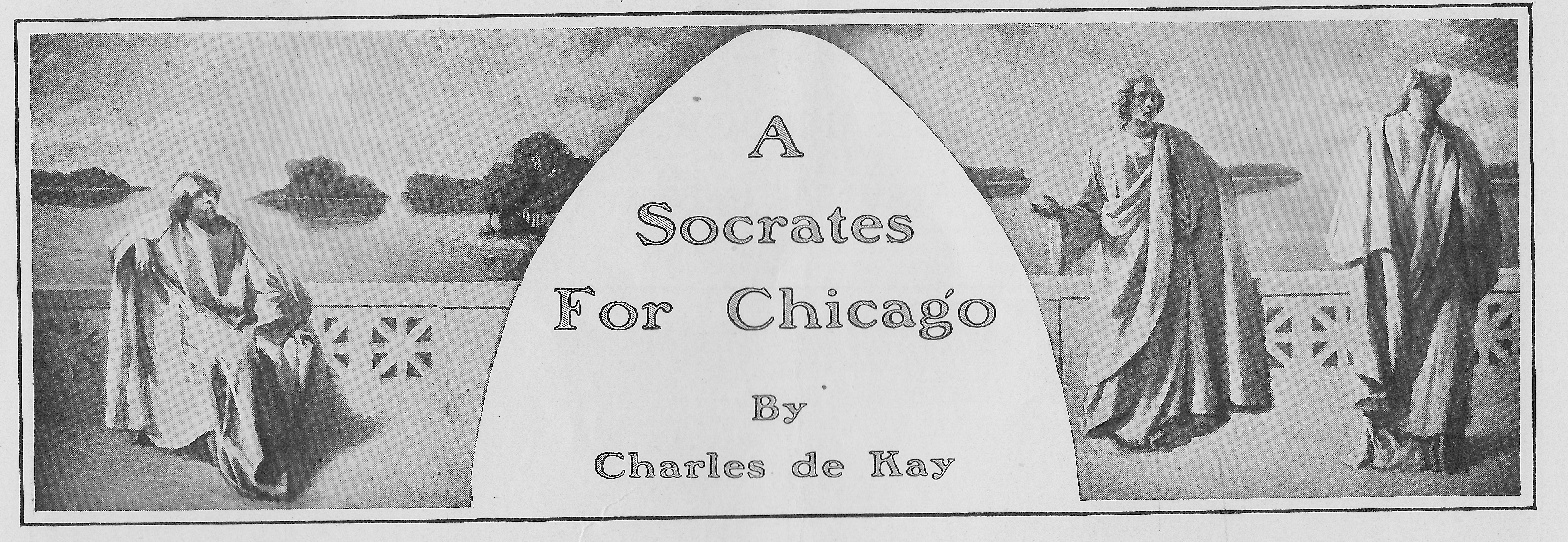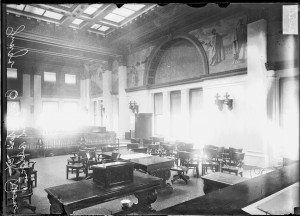
Public art in Federal Plaza today. The plaza outside the Kluczinski and Dirksen Federal Buildings desiged by Mies van der Rohe features Alexander Calder’s “Flamingo”
The Old Federal Building that once stood on the site of Federal Plaza in the LOOP featured a mural depicting the Athenian philosopher Socrates (469-399 BC) in one of its courtrooms.

Illustrated title for the June 12, 1909 Harper’s Weekly article about van Ingen’s murals in the Chicago Federal Building. The title occupies space filled with an inscription in the courtroom mural.
Constructed between 1898 and 1905, murals depicting the history of the rule of law and justice painted by William B. van Ingen were added to the courtrooms in 1909. The entire Old Federal Building was unceremoniously demolished in 1965.
We have a record of the Socrates mural’s composition because its installation caught the attention of Charles de Kay, an art critic for Harper’s Weekly, and an unpublished image taken by a Chicago Daily News photographer survives in the Chicago History Museum’s archives.
The composition places Socrates with his back to the viewer at the far right in a manner that invites the viewer to assume his place in the conversation. The other men listen intently. Van Ingen seems to conjure Socrates as we find him in Plato’s Republic — a calm, rational person focused on the investigation at hand — and not necessarily as the nonconformist intellectual admired, lampooned and ultimately executed by his contemporaries.
Van Ingen intended to place his “Socrates Discoursing about Justice” in a particular courtroom — that of Kenesaw Mountain Landis, the jurist who in 1907 had, in this very building, presided over the celebrated anti-trust suit against Standard Oil of Indiana that fined the company over $29 million for taking rebates from railways shipping companies in violation of federal law. The fine was overturned on appeal the following year. Nevertheless, Landis secured a reputation for standing up to big business and powerful authorities. Perhaps the painter expected the Socrates mural to celebrate his reason and fortitude. If so, the Judge had other ideas. He objected to the painter’s desire to place a portrait of a remote historical figure in his courtroom. He wanted a depiction of Lincoln in his courtroom — and he got his wish. The Socrates mural went up in another courtroom in the building.
William B. van Ingen is best known for spectacular murals depicting the construction of the Panama Canal installed in the Adminstration Building in Panama as well as contributions to the decoration of the Library of Congress.
Judge Kenesaw Mountain Landis went on to become the first Commissioner of Baseball in the wake of the Black Sox scandal of 1920.
See another photograph of the old Chicago Federal Building.
(S.S.M.)


